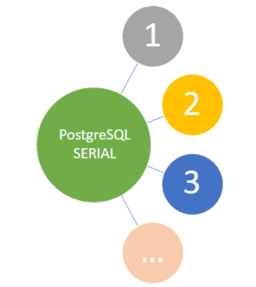Using PostgreSQL SERIAL to Create Auto-increment Column
 Summary: in this tutorial, you will learn about the PostgreSQL
Summary: in this tutorial, you will learn about the PostgreSQL SERIAL pseudo-type and how to use the SERIAL pseudo-type to define auto-increment columns in tables.
Introduction to the PostgreSQL SERIAL pseudo-type
In PostgreSQL, a sequence is a special kind of database object that generates a sequence of integers. A sequence is often used as the primary key column in a table.
When creating a new table, the sequence can be created through the SERIAL pseudo-type as follows:
CREATE TABLE table_name(
id SERIAL
);By assigning the SERIAL pseudo-type to the id column, PostgreSQL performs the following:
- First, create a sequence object and set the next value generated by the sequence as the default value for the column.
- Second, add a
NOT NULLconstraint to theidcolumn because a sequence always generates an integer, which is a non-null value. - Third, assign the owner of the sequence to the
idcolumn; as a result, the sequence object is deleted when theidcolumn or table is dropped
Behind the scenes, the following statement:
CREATE TABLE table_name(
id SERIAL
);is equivalent to the following statements:
CREATE SEQUENCE table_name_id_seq;
CREATE TABLE table_name (
id integer NOT NULL DEFAULT nextval('table_name_id_seq')
);
ALTER SEQUENCE table_name_id_seq
OWNED BY table_name.id;PostgreSQL provides three serial pseudo-types SMALLSERIAL, SERIAL, and BIGSERIAL with the following characteristics:
| Name | Storage Size | Range |
|---|---|---|
| SMALLSERIAL | 2 bytes | 1 to 32,767 |
| SERIAL | 4 bytes | 1 to 2,147,483,647 |
| BIGSERIAL | 8 bytes | 1 to 9,223,372,036,854,775,807 |
PostgreSQL SERIAL examples
Let’s take some examples of using the SERIAL columns.
1) Basic PostgreSQL SERIAL example
It is important to note that the SERIAL does not implicitly create an index on the column or make the column the primary key column. However, this can be done easily by specifying the PRIMARY KEY constraint for the SERIAL column.
The following statement creates the fruits table with the id column as the SERIAL column:
CREATE TABLE fruits(
id SERIAL PRIMARY KEY,
name VARCHAR NOT NULL
);To assign a default value to a serial column when inserting a row into the table, you ignore the column name or use the DEFAULT keyword in the INSERT statement. For example:
INSERT INTO fruits(name)
VALUES('Orange');Or
INSERT INTO fruits(id,name)
VALUES(DEFAULT,'Apple');PostgreSQL inserted two rows into the fruits table with the values for the id column are 1 and 2.
SELECT * FROM fruits;id | name
----+--------
1 | Apple
2 | Orange
(2 rows)2) Getting the sequence name
To get the sequence name of a SERIAL column in a table, you use the pg_get_serial_sequence() function as follows:
pg_get_serial_sequence('table_name','column_name')You can pass a sequence name to the currval() function to get the recent value generated by the sequence. For example, the following statement returns the recent value generated by the fruits_id_seq object:
SELECT currval(pg_get_serial_sequence('fruits', 'id'));currval
---------
2
(1 row)3) Retrieving the generated value
If you want to get the value generated by the sequence when you insert a new row into the table, you use the RETURNING id clause in the INSERT statement.
The following statement inserts a new row into the fruits table and returns the value generated for the id column.
INSERT INTO fruits(name)
VALUES('Banana')
RETURNING id;id
----
3
(1 row)The sequence generator operation is not transaction-safe. It means that if two concurrent database connections attempt to get the next value from a sequence, each client will get a different value.
If one client rolls back the transaction, the sequence number of that client will be unused, creating a gap in the sequence.
4) Adding a serial column to an existing table
First, create a new table called baskets without a primary key column:
CREATE TABLE baskets(
name VARCHAR(255) NOT NULL
);Second, add a SERIAL column to the baskets table:
ALTER TABLE baskets
ADD COLUMN id SERIAL PRIMARY KEY;Third, describe the table baskets to verify the change:
\d basketsOutput:
Table "public.baskets"
Column | Type | Collation | Nullable | Default
--------+------------------------+-----------+----------+-------------------------------------
name | character varying(255) | | not null |
id | integer | | not null | nextval('baskets_id_seq'::regclass)
Indexes:
"baskets_pkey" PRIMARY KEY, btree (id)Summary
- Use the PostgreSQL pseudo-type
SERIALto create an auto-increment column for a table.